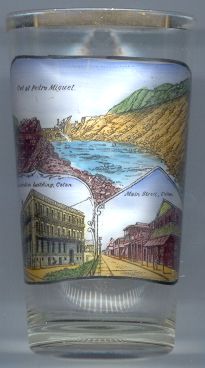

|
| PANAMÁ | PANAMA |
| provincias: Panamá, Colón |
| en: Panama Canal |
 The Panama Canal bisects the continents of North and South America, cutting through the isthmus of Panama, and
connecting the Atlantic and Pacific Oceans in Central America. The construction of the canal was one of the largest and most
difficult engineering projects ever undertaken and had an enormous impact on shipping, as it removed the need for ships to
travel the long and treacherous route via the Drake Passage and Cape Horn at the southernmost tip of South America.
A ship sailing from New York to San Francisco via the Panama Canal travels a distance of 5,264 miles (8,472 km),
a savings of more than 7,800 miles (12,500 km) over the 13,100 mile (21,000 km) route around Cape Horn.
The Panama Canal bisects the continents of North and South America, cutting through the isthmus of Panama, and
connecting the Atlantic and Pacific Oceans in Central America. The construction of the canal was one of the largest and most
difficult engineering projects ever undertaken and had an enormous impact on shipping, as it removed the need for ships to
travel the long and treacherous route via the Drake Passage and Cape Horn at the southernmost tip of South America.
A ship sailing from New York to San Francisco via the Panama Canal travels a distance of 5,264 miles (8,472 km),
a savings of more than 7,800 miles (12,500 km) over the 13,100 mile (21,000 km) route around Cape Horn.
Although the concept of a canal in Panama dates back to the early 1500s, the first attempt to construct a canal began in 1880, under French leadership. The building of the 51 mile (82 km) canal was plagued by problems, including disease (particularly malaria and yellow fever), and massive landslides. As many as 27,500 workers are estimated to have died during construction; around 22,000 during the French period (1881–1889), and 5,609 during the American construction (1904–1914). The work was finally completed by the United States, and the canal opened in 1914. Each year the canal accommodates the passage of over 14,000 ships, carrying over 203 million tonnes of cargo. Approximately 800,000 ships have passed through the Panama Canal since its completion.
The United States obtained control of the Canal Zone in exchange for helping Panama to declare independence from Colombia in 1903. The canal and the zone surrounding it were originally administered by the United States. However, on 7 September 1977, U.S. President Jimmy Carter and Panamanian leader Omar Torrijos signed the Torrijos-Carter Treaties, which set in motion the process of handing over the canal to Panamanian control. The treaties ('The Treaty Concerning the Permanent Neutrality and Operation of the Panama Canal', commonly referred to as the 'Neutrality Treaty' and 'The Panama Canal Treaty') came into force on 31 December 1999, since when the canal has been run by the Panama Canal Authority (Autoridad del Canal de Panamá, ACP).
The top picture on glass no. 2072 shows a view of the construction of the canal,
the  cut
cut
The bottom pictures show two views from the city of Colón at the Atlantic end of the canal.
[Text modified from http://en.wikipedia.org/wiki/Panama_Canal]
![[scale]](lineal.jpg)